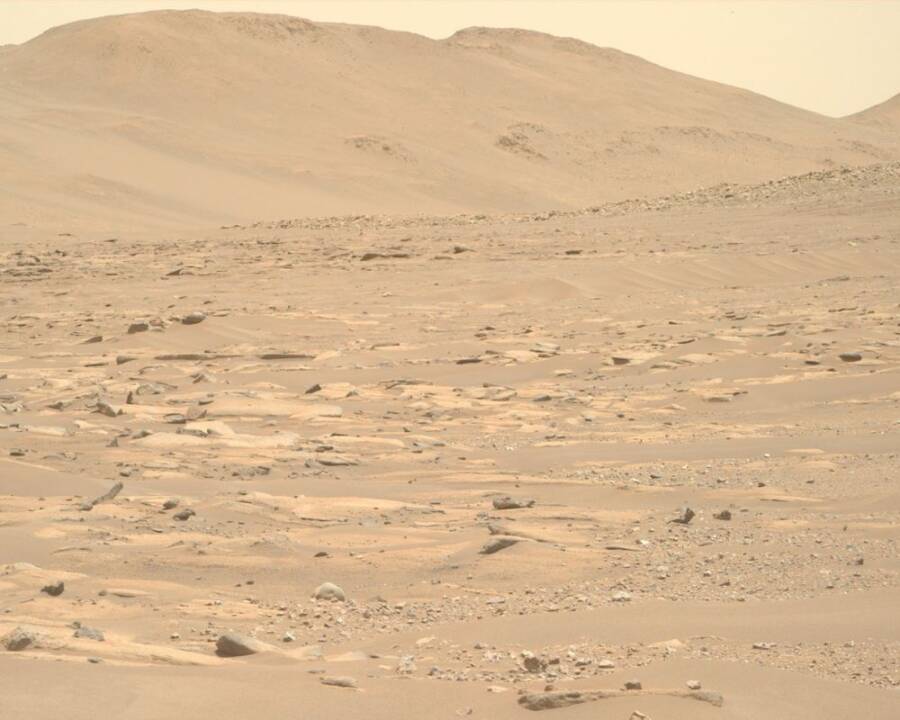The Perseverance rover collected samples that may indicate there was once microbial life on Mars from a crater that held a massive lake billions of years ago.
A NASA rover exploring a large crater on Mars has discovered that the basin once held a massive lake and a river delta.

NASAA mock-up of how the lake in Jezero crater may have appeared billions of years ago.
The Perseverance rover landed on Mars back in February 2021. Since then, it has steadily been collecting samples, looking for signs of life on the Red Planet.
The rover has spent the last three years exploring Jezero crater, which is 28 miles wide and was formed by an asteroid impact nearly four billion years ago. While exploring the site and searching for samples, Perseverance found evidence that the sprawling crater was actually once a lake.
“We picked Jezero Crater as a landing site because orbital imagery showed a delta — clear evidence that a large lake once filled the crater,” said Ken Farley, Perseverance’s project scientist, in a press release from NASA. “A lake is a potentially habitable environment, and delta rocks are a great environment for entombing signs of ancient life as fossils in the geologic record.”
Farley continued, “After thorough exploration, we’ve pieced together the crater’s geologic history, charting its lake and river phase from beginning to end.”
Scientists were able to put together a detailed timeline of the lake’s history, which is separated into three distinct periods.

Facebook/NASA’s Perseverance Mars RoverThis may have once been the shoreline of the lake in Jezero crater.
In the first period, fine sand and mud known for preserving fossil life made its way into the crater. Next, sedimentary layers formed as the lake expanded, stretching 22 miles across and reaching depths of 100 feet. Finally, “high-energy rivers” formed that carried boulders across the surface of Mars.
“We were able to see a broad outline of these chapters in Jezero’s history in orbital images, but it required getting up close with Perseverance to really understand the timeline in detail,” said Libby Ives, a post-doctoral fellow at NASA’s Jet Propulsion Laboratory.
During its 1,000 days on Mars, the Perseverance rover has collected 23 rock samples from the crater. The robot bores into the ground and removes a chunk of rock about the size of a stick of chalk. It then stores the sample in a specially-made metal tube.
Some of these samples have contained signs that the lake may have been home to microbial life, according to NASA.
“Scientists see evidence that water carried clay minerals from the surrounding area into the crater lake,” states NASA’s website. “Conceivably, microbial life could have lived in Jezero during one or more of these wet times. If so, signs of their remains might be found in lakebed or shoreline sediments. Scientists will study how the region formed and evolved, seek signs of past life, and collect samples of Mars rock and soil that might preserve these signs.”
Perseverance has collected two samples to date that possibly indicate ancient life on Mars. One sample contained a notable amount of silica, which preserves fossils here on Earth. And a second sample showed a large quantity of phosphate, which is a critical building block in life on Earth. It is a component of DNA and is found in cell membranes.

Facebook/NASA’s Perseverance Mars RoverThe Perseverance rover on the surface of Mars.
Perseverance has also determined the crater floor is made up of igneous rock formed from magma or volcanic activity underground. Above the igneous rock, there are layers of sandstone and mudstone, indicators of the formation of the rivers that flowed into the lake. The mudstone is also rich in salt, indicating that the lake experienced evaporation.
The rover is able to determine the make-up of the rock using the specialized instruments it’s fitted with. These tools are capable of detecting both microscopic fossil-like structures and chemical changes left behind by ancient microbes, but so far it hasn’t recorded either of these signs of life.
Still, NASA scientists remain hopeful that the evidence is out there. Morgan Cable, a research scientist at the Jet Propulsion Laboratory, noted, “We have ideal conditions for finding signs of ancient life where we find carbonates and phosphates, which point to a watery, habitable environment, as well as silica, which is great at preservation.”
After learning about the crater on Mars that used to hold a lake, read about the former NASA scientist who claims we found life on the Red Planet 50 years ago. Then, listen to what seismic activity on Mars sounds like.





